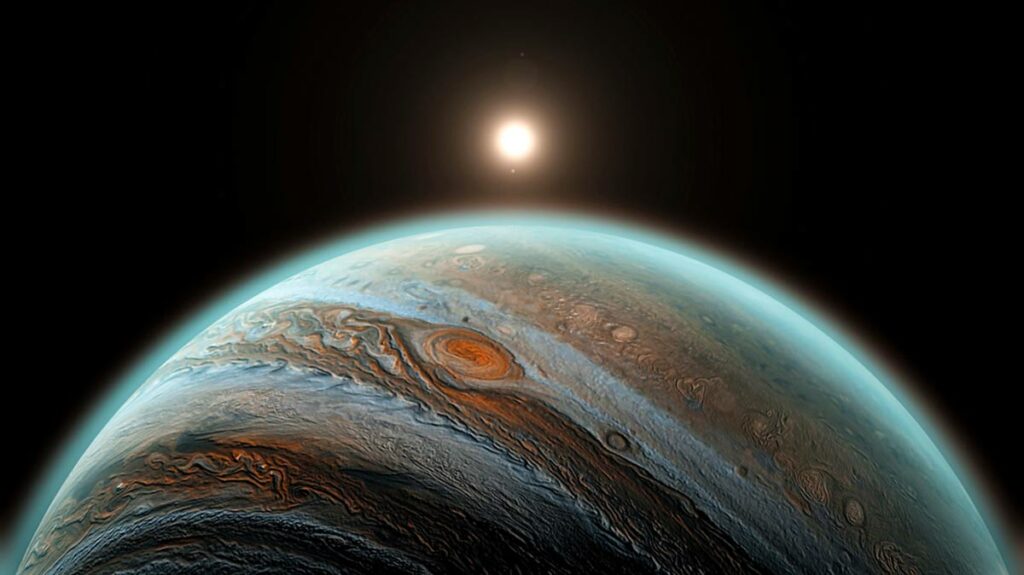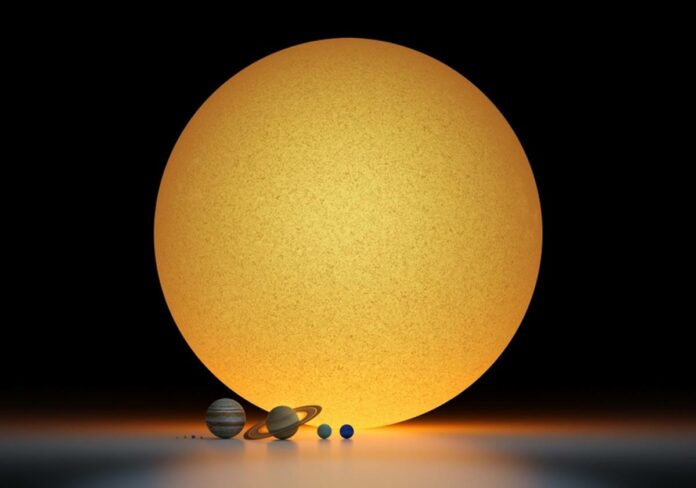Have you ever wondered how vast the universe is and how celestial bodies compare in size? In this article, we will explore the fascinating question of how many Jupiter’s can fit inside our mighty Sun.
Jupiter, the largest planet in our solar system, is often regarded as a behemoth, but when it comes to the Sun, its immense size puts everything else into perspective.
Understanding the Size of Jupiter and the Sun
Before diving into calculations and comparisons, let’s gain a basic understanding of the sizes of Jupiter and the Sun.
Jupiter has a diameter of approximately 86,881 miles (139,820 kilometers), making it the largest planet in our solar system.
On the other hand, the Sun, our radiant star, has a diameter of about 864,000 miles (1,391,000 kilometers). These measurements set the stage for our exploration.
Comparing the Sizes of Jupiter and the Sun
Diameter of Jupiter
Jupiter’s diameter, as mentioned earlier, is around 86,881 miles (139,820 kilometers).
To put this immense size into context, it is more than 11 times larger than Earth’s diameter.
Picture a colossal sphere floating through space, encompassing a vast volume.
Diameter of the Sun
Now, let’s shift our focus to the Sun.
With a diameter of approximately 864,000 miles (1,391,000 kilometers), the Sun is an astronomical giant.
It dwarfs not only Earth but also all the planets in our solar system, including Jupiter.
Its size is truly mind-boggling, leaving us in awe of the cosmic wonders.

How Many Jupiter’s Can Fit in the Sun?
Now, let’s calculate how many Jupiter’s could fit within the Sun’s colossal volume.
The volume of a sphere can be determined using the formula:
V = (4/3) * π * r^3Where:
- V represents the volume of the sphere,
- π is a mathematical constant (approximately 3.14159),
- and r is the radius of the sphere.
To calculate the number of Jupiter’s that can fit in the Sun, we need to compare their volumes.
Considering that the radius of Jupiter is approximately 69,911 kilometers (43,441 miles), and the radius of the Sun is roughly 695,700 kilometers (432,450 miles), we can proceed with the calculations.
Substituting the values into the formula, we get:
V_Sun = (4/3) * π * (695,700 km)^3
V_Jupiter = (4/3) * π * (69,911 km)^3Calculating these values will allow us to determine the ratio of the Sun’s volume to that of Jupiter.
Now, let’s delve deeper into the calculations to find out the astonishing answer.
Calculating the Volume of the Sun
To calculate the volume of the Sun, we substitute the radius of the Sun into the formula:
V_Sun = (4/3) * π * (695,700 km)^3By performing the calculation, we find that the volume of the Sun is approximately 1.41 x 10^18 cubic kilometers (8.355 x 10^17 cubic miles).
Calculating the Volume of Jupiter
Similarly, by substituting the radius of Jupiter into the formula, we can calculate its volume:
V_Jupiter = (4/3) * π * (69,911 km)^3After performing the calculation, we find that the volume of Jupiter is approximately 1.43 x 10^15 cubic kilometers (3.43 x 10^14 cubic miles).
Determining the Ratio
Now, let’s determine the ratio of the Sun’s volume to that of Jupiter by dividing the volume of the Sun by the volume of Jupiter:
Ratio = V_Sun / V_JupiterSubstituting the calculated values, we find:
Ratio = (1.41 x 10^18 cubic km) / (1.43 x 10^15 cubic km)By performing the division, we discover that approximately 986.014 Jupiter’s can fit within the volume of the Sun.
This astonishing figure illustrates the sheer magnitude of the Sun’s size compared to that of Jupiter.
It truly highlights the grandeur and vastness of our star, which serves as the center of our solar system.
Significance of the Findings
The findings from our calculations hold significant scientific and educational value.
They provide us with a fresh perspective on the vastness of celestial bodies and the intricate dynamics of our solar system.
Understanding the size relationships between Jupiter and the Sun can inspire curiosity and wonder about the marvels of the universe.
Conclusion
In conclusion, the question “How Many Jupiter’s Can Fit in the Sun?” leads us on an awe-inspiring journey through the vastness of our solar system.
Through careful calculations, we have determined that approximately 986.014 Jupiter’s can fit within the volume of the Sun.
This staggering number showcases the sheer scale of these celestial bodies and provides us with a glimpse of the cosmic wonders that exist beyond our planet.
Next time you gaze up at the night sky and marvel at the beauty of Jupiter and the Sun, remember the incredible size disparity between them.
Let this knowledge fuel your curiosity and inspire you to explore the mysteries of the universe.
FAQs
Jupiter’s mass is significantly smaller than the Sun’s. The Sun’s mass is about 1,048 times greater than that of Jupiter, highlighting the vast difference in their sizes and compositions.
Yes, the size of the Sun significantly affects its gravitational pull on Jupiter and all other celestial bodies within its gravitational field.
Yes, there are stars much larger than the Sun. For example, UY Scuti is currently considered the largest known star.
Jupiter is approximately 11 times larger in diameter than Earth. It is a gas giant, while Earth is a rocky planet.
No, the size difference between Jupiter and the Sun is not visually apparent from Earth without the aid of specialized instruments or imagery.
No, Jupiter and the Sun are separated by a vast distance in our solar system. Their orbits ensure that they will never collide.
No, the number remains constant as the sizes of Jupiter and the Sun do not change significantly over short periods of time.
Yes, exoplanets larger than Jupiter have been discovered orbiting other stars. Some of these gas giants are even more massive than Jupiter.
Yes, NASA’s Juno spacecraft has been studying Jupiter since 2016, providing valuable insights into the planet’s atmosphere, magnetic field, and composition.
The density of Jupiter is significantly lower than that of the Sun. Jupiter is primarily composed of gas and lacks the intense pressure and heat found in the Sun’s core.
Yes, although the gravitational pull of Jupiter is significant, it does not have a noticeable direct effect on Earth. The gravitational influence of the Moon and the Sun play more prominent roles in Earth’s tides and orbital dynamics.
No, Jupiter’s largest moon, Ganymede, is the largest moon in our solar system. However, Ganymede is still much smaller than Jupiter itself.


This article provides a fascinating exploration of the size comparison between Jupiter and the Sun, shedding light on the immense scale of celestial bodies. The calculations presented in the article reveal that approximately 986.014 Jupiter’s can fit within the volume of the Sun. This figure highlights the staggering difference in size and emphasizes the grandeur of our star.
The significance of these findings lies in the scientific and educational value they offer. Understanding the size relationships between celestial bodies such as Jupiter and the Sun deepens our appreciation for the vastness of the universe and the intricate dynamics within our solar system. It serves as a reminder of the wonders that exist beyond our planet and sparks curiosity to explore further.
Overall, this article prompts us to contemplate the awe-inspiring nature of the cosmos and encourages us to marvel at the beauty and scale of celestial objects like Jupiter and the Sun. It serves as a reminder of our place in the universe and the limitless possibilities that lie beyond.
Hi, Dane
Thank you for reading this article.
Have A Nice Day, Thanks
This article provides a fascinating exploration of the size comparison between Jupiter and the Sun. It presents the diameter and volume of both celestial bodies and then calculates how many Jupiter’s could fit inside the Sun. The findings, which reveal that approximately 986,014 Jupiter’s can fit within the volume of the Sun, highlight the immense scale of these cosmic entities and inspire a sense of wonder about the vastness of the universe. Overall, the article offers valuable scientific and educational insights into the size relationships within our solar system.
Thanks For Reading Article
Very interesting article.